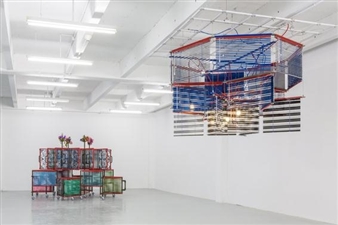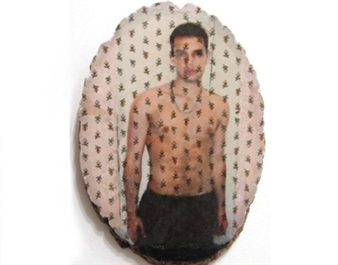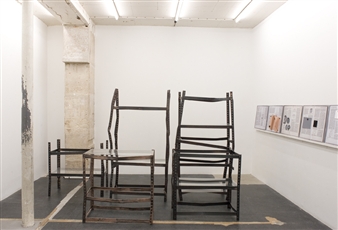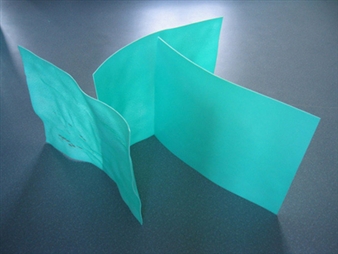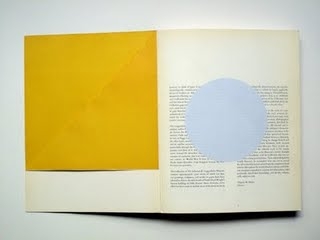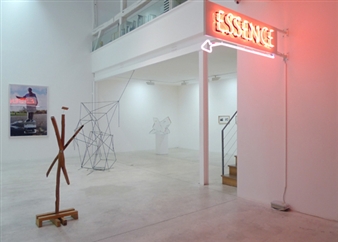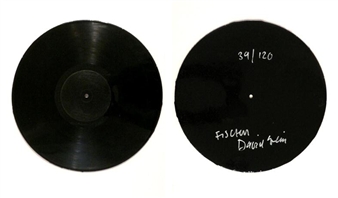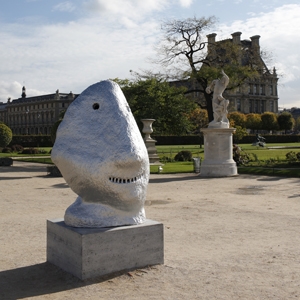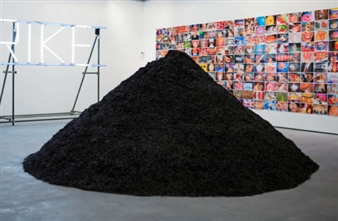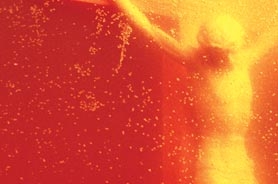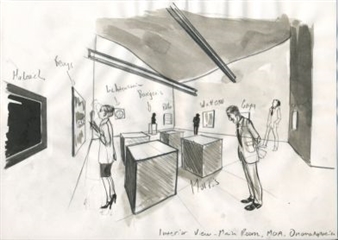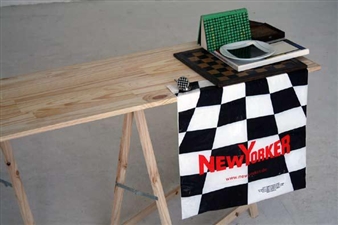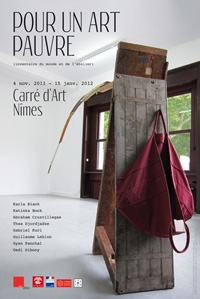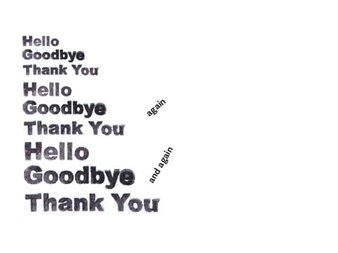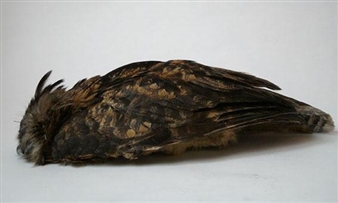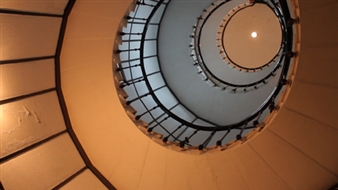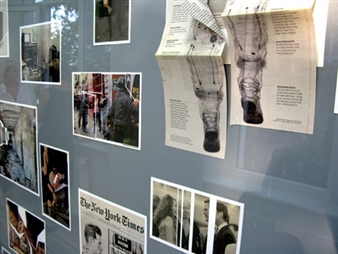Le kiosque noir
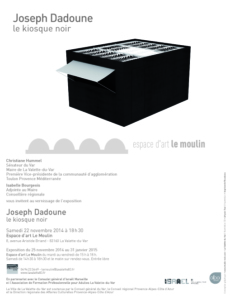
Espace d'art Le Moulin, Provence-Alpes-Cote d'Azur, Villars-sur-var, 11/22/2014 - 01/31/2015
8 Avenue Aristide Briand
The open work by Joseph Dadoune
Texte By : Fabrice Flahutez
Art critic and historian, Paris Ouest University.
These days an interesting piece of art work must always ask more questions than it answers.
As art work, when all is said and done, is a reality that questions not only its own history, but also, as Marcel Duchamp wished, the terms of what it provokes in the viewer. Without any form of guidance, art works could thus metaphorically be clouds where, from whichever angle we decide to traverse them, the spirit is immediately caught up in the mist itself. The chaos of the undetermined and the irrational would thus be where the poetry begins.
This is what we often find with Joseph Dadoune, a perplexity regarding the perspectives that trace his art work through the stigmata of his biography drawn out between France and Israel.
In vain does one seek to measure, quantify, identify, classify, understand a proposition such as is made by this art work, yet it does not matter as one wins in the end. Michel Foucault would see here a series of interactions between histories that validate and exclude themselves, a production of singularities.
The art work of Joseph Dadoune presented by the espace d'art Le Moulin is not what, at first glance, one would initially like it to be. It is not a discourse on the history of the East as seen from the balcony of the western world, nor is it a history of the West and the construction of an idealized East.
The work presented here is not easy to circumscribe as it is an « heir without a will » open to all interpretations. Joseph Dadoune gives us an art work that is traversed by a multitude of flux, a crystal with many facets contrary to many of his contemporaries who seek to be explicit. Because, as one often sees in the columns of cultural magazines one artist works on memory yet another works on identity or history, on those small recipes which make each artist to be a studious craftsman toiling on a quantifiable mission? At a time when « Le déshonneur des poètes » (ed. Bussière-Acratie, 2014) by Benjamin Péret, is being re-published it is primordial to pause for a while before the work of Joseph Dadoune whose merit is not being at the service of any form of topical poem seeking to seduce the establishment or the wallet of misguided art collectors.
Of course, the work evokes international current affairs, but not just these. There are four different axes that are organized around « Printemps arabe », « Fayçal, roi d’Arabie », « Fayçal-Moshé », « Les pittas ». The fall of the authoritarian regimes in North Africa commonly referred to as the « Arab spring » is directly echoed in one of the series of his work.
Jospeh Dadoune re-appropriates the paperback edition of the book by Jacques Benoist-Méchin (1901-1983)
entitled « An Arab spring », written in 1959 and re-published at the end of 1975, to link it not only to recent events but also to his own life as he himself was born in Nice in 1975. It is also strange to note that the title « Arab spring » has passed (airily) through the history of the 20th century (so lightly).
Telescoping twice as Jacques Benoist-Méchin, who was involved in both France of Vichy and the enthusiastic author ofEnlightenings on « Mein Kampf » by Adolf Hitler, the book which changed the face of the world, published by Albin Michel just before the war in 1939. His being condemned to death in 1947 for active collaboration with the Nazis does not put us off as he was « swiftly » pardoned by both history and the men of his time.
Benoist-Méchin the colonialist, however takes over the East in 1959 in 1959 to make it into a Western motif. The image on the cover of the 1975 edition is moreover astonishing with the improbable pose of the young boy with white teeth gathering corn and looking straight into the eyes of the reader. What does this image and this text say today ? Just as the « Arab spring » by Benoist-Méchin could be classified as a « modern » history book with a deciding view of history in 1959, its re-publication in 1975, then as the event title for North Africa in 2011, now in the work presented here as a relic, gives it as an example of the post-modernity fully assumed by Joseph Dadoune.
There is Arab Spring, but it is not that of Benoist-Méchin, neither is it that of 2011, it is that of Joseph Dadoune. As Jean Baudrillard would have said, the Arab spring has never existed as it it simply a “flux of information” which runs out through the forgetfulness of the media. History no longer exists, not even the great history of the Western world, there is only a flux of non-events, a flux of images and sounds which are mixed up, clash together and then repeat themselves.
The book-image of the Arab Spring meets the motifs of the pittas, of which one of the faces is painted black whereas the other is left natural. One can easily see that Joseph Dadoune is not making a work of quotation since he places the pittas-Benoist-Méchin juxtaposition in a proposition of a random combination of cards. Each of the images shows the black-pittas which alternate with the book by Benoist-Méchin in the manner of a deck of cards revealing the 16 numerical possibilities of the propositions. The multiple combinations of the different series which appear randomly draw one also to think of a game of chess through the alternating blacks and whites with checkmate as a possibility ? Elsewhere, the other series shows by way of a book, he who Benoist-Méchin entitled Fayçal, King of Arabia : the man, the sovereign, his place in the world as he appeared in the paperback to a wide audience in 1975.
The two works and the figure of Fayçal are not surrounded by the black pittas whereas the fourth series is composed of black pittas which alternate with the naturally white pittas. The colour of the ittas also reminds one of dominoes and, through a play with language, the games of domination and the relationships of power.
A bi-chromatic system which expresses the duality of the representations in which we are all plunged, bogged down. White-Black ; Petrol versus food ; East-West : Eastern world – Western world : North-South ; Feminine-Masculine ; Art- Non-art ; Good-Evil etc.
Without doubt the multiplication of the pittas also refers to the multiplication of the bread, the feeding of the five thousand, whose semantic value prefigures in the Last Supper where all the actors finally come together around a table. One can see that the work of Dadoune opens up to an infinity of interpretations according to whatever the viewer wishes for. The viewer himself constructs his own interpretation and writes the story. A beautiful metaphor in a contemporary world in total decay where one loses oneself in the abundance of signs that are all interchangeable.
The cards of Joseph Dadoune are poetically the cards which talk of a future open to an infinite number of possibilities; The artist thus deals the cards and offers them for our interpretation, a subjective, sensitive, random and poetic reading since they do not stand up to a realistic examination. In the centre of the installation, the black kiosk covered with palm tree branches is a sort of sukkah as an invitation, a refuge and a dwelling out of time, where everything begins. The desire to live beyond history is not uncommon as Charles Baudelaire writes in Chant d'automne in 1861, because soon « all of winter will return to my soul » ?
